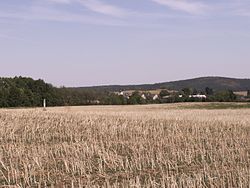Vysoká (Bruntál District)
This article does not cite any sources. (March 2016) |
Vysoká | |
|---|---|
Municipality and village | |
 Vysoká | |
 Flag  Coat of arms | |
 Vysoká Location in the Czech Republic | |
| Coordinates: 50°15′35.53″N 17°35′22.48″E / 50.2598694°N 17.5895778°ECoordinates: 50°15′35.53″N 17°35′22.48″E / 50.2598694°N 17.5895778°E | |
| Country | |
| Region | Moravian-Silesian Region |
| District | Bruntál District |
| Area | |
| • Total | 6.61 sq mi (17.11 km2) |
| Elevation | 920 ft (280 m) |
| Population (2011) | |
| • Total | 345 |
| • Density | 52/sq mi (20/km2) |
| Time zone | UTC+1 (CET) |
| • Summer (DST) | UTC+2 (CEST) |
Vysoká (German: Waißak) is a village and municipality in Bruntál District in the Moravian-Silesian Region of the Czech Republic.
Location[]
Vysoká municipality is situated on the main road to Poland on the Polish border. The border can be crossed by car in the local municipality of . In settlement the Petrovický stream runs to Mušlov creek and creates the Osoblaha river. The first mention of the municipality is from 1267 and currently it has a population of 345.
History[]
The dominant feature of the village is the baroque Church of St. Urban from 1767 with its roof and tower being reconstructed recently. In Pitárne village there is the parish Church of the Virgin Mary from 1776 with similar dispositions. In the local Bartultovice municipality visitors may admire the Column of the Crucification from the early 17th century dedicated to St. Florian. Close to the Column there is so called „Radvanský stone“ from 1760 which commemorates the death of the Hungarian officer Radvanský. The third monument at the same location is the glacial erratic boulder. Monuments are accessible from the former Polish border crossing as well as from the Western restaurant down the local road. If we carry on approximately 50 metres from the restaurant we can reach another valuable monument in Bartultovice municipality – a wayside cross from the 17th century which illustrates how the medieval criminal law was claimed. The roughly hewn cross stone recalls the Swedish officer murder caused probably by the villagers from the backup. The cross should represent conciliation and regret over this murder.
The city of Prudnik situated nearly six kilometres from borders of the Czech Republic is also worth a visit. It has a well-preserved historical centre which is dominated by the so-called „Vok Tower“ which is a remnant of a stone castle built by Rosenbergs. You may reach the city by car or by bicycle with no hassle travelling through Polish Trzebina where you turn left over the main road in the village centre. Than you go along the Franciscan monastery by the Franciscan Hill (Klasztorna Gora) situated in the forest south of Prudnik. From there you continue down the hill to the north towards Prudnik.
| Wikimedia Commons has media related to Vysoká (Bruntál District). |
- Populated places in Bruntál District
- Villages in Bruntál District
